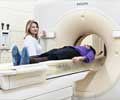An Indian-origin researcher in the US says that CT scanners may offer a cheaper alternative to the current methods of evaluating and diagnosing low-risk chest pain patients in the emergency room, which involve an overnight stay in the observation unit and cardiac stress testing.
Dr. Rahul Khare, assistant director of operations at Northwestern Memorial Hospital, points out that a commonly missed and difficult to diagnose cause of chest pain is coronary artery disease.And, he adds, the 64-slice CT scanner has been found to effectively diagnose coronary artery disease.
"When patients arrive to the emergency department with chest pain, my goal as an emergency physician is to identify any life threatening conditions and treat the patient promptly. Currently it is a challenge to identify chest pain patients with significant coronary artery disease in a timely and cost-effective manner," says Dr. Khare, who is also an Assistant Professor of Emergency Medicine at Northwestern University's Feinberg School of Medicine.
"Some have advocated the use of the CT scanner in the emergency department for low-risk chest pain patients as an alternative to stress testing. The CT scanner has the potential to become a first-line screening instrument, but before that happens, we have to evaluate whether or not the cost is associated with better patient outcomes," he says.
Dr. Khare recruited a 54-year old patient for his study, and used a computer model to evaluate the cost-effectiveness of the CT scanner within three different risk categories-very low risk, low risk, and moderate risk patients.
He found that the cost of using the CT scanner was lower than the cost of an observation unit stay and stress testing for all three categories.
Advertisement
"There is good evidence that the use of this technology will be the standard of care in the future, and we must determine if the benefit will outweigh the cost. This study shows that it does, and more importantly, that it may even be cost-saving in certain situations. Ultimately, this new technology may be the best care for the patient by quickly telling the patient and the physician if the chest pain is due to a blocked coronary artery," he adds.
Advertisement
SPH












